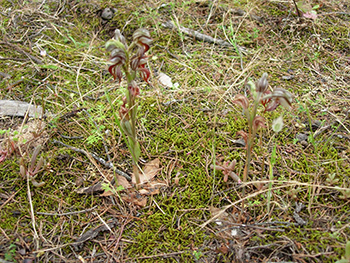Native plant - Sandhill greenhood orchid
- Fact sheet
- August 2015

Description
- plants are solitary and have a tuberous root system
- leaves form a rosette on the ground and have usually died down by the time of flowering
- each plant has 1-10 flowers
- flowers have ‘hoods’ that are green and brown, or red-brown with white markings.
Ecology
- flowers from September to December
- seed matures between November and December
- plants become dormant from end December, after seeds have set, to June of the following year.
Conservation rating
Sandhill greenhood orchid is listed as nationally vulnerable – approximately 93,200 plants in the Murraylands and Riverland region.
Threats
- grazing (kangaroos, stock and rabbits)
- weed competition (bridal creeper and perennial veldt)
- illegal plant collection and flower picking
- small population size.

Habitat
Found in mallee and native pine woodlands. In mallee habitats, the overstorey is dominated by:
- coastal white mallee (Eucalyptus diversifolia)
- golden wattle (acacia pycnantha)
- mallee box (Eucalyptus porosa)
- drooping sheoak (Allocasuarina verticillata).
The undergrowth is typically dominated by scattered shrubs over native heaths and sedges and scattered grasses.
In native pine woodland habitats, the overstorey is dominated by:
- southern cypress pine (Callitris preissii)
- drooping sheoak (Allocasuarina verticillata).
The undergrowth is typically dominated by native grasses and saltbushes.
Distribution
South Australia. Populations can be found in:
- Tailem Bend
- Coorong National Park
- Meningie.
How you can help
Please be aware of native plants and help preserve them by:
- Preventing damage caused by grazing
- Preventing removal/illegal collection
- Controlling weeds to reduce competition
- Taking a photo instead of picking native flowers
- Volunteering with the Murraylands and Riverland region or joining your local native vegetation group
- Reporting any sightings of these endangered plants to our offices (contact details below).